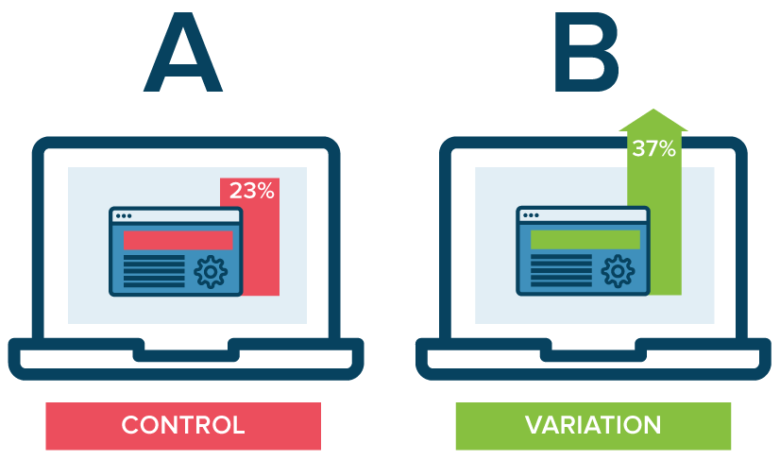A well-structured A/B testing program helps online businesses find which website elements work best for their specific website and audience, so they can optimize them and give their visitors the best experience.
Unfortunately, not all online business owners have embraced A/B testing. Some give more priority to business-generating activities than testing because they believe it’s either expensive, time-consuming, or complicated.
If you’re one of them, you’re missing out on many opportunities to increase your website conversions, boost your revenue, and increase profitability by reducing the cost of acquisition and conversion. Before moving on, check out what conversion cost is at this link.
Here are six significant benefits of A/B testing that may make you change your mind.
1. Helps Businesses to Embrace a Culture of Experimentation

In traditional (top-down) organizations, top-level officials make the decisions, which are often based on their desires and opinions.
Sometimes, those decisions are correct, and other times they’re wrong. In such organizations, ideas from low-ranking employees are never taken seriously, however great they’re.
A/B testing helps organizations embrace a culture of experimentation where decisions are made based on data and not the opinion or gut instinct of some high-ranking official.
All employees are given a chance to present their ideas, then tested to determine the concept with the most impact on your business. This goes a long way to boost staff morale and encourage teamwork.
2. Improves User Experience
Improved user experience is another benefit of A/B testing. Visitors usually have a specific goal to achieve when they come to your website. It may be to buy your product or service, read more about a topic that interests them, or browse.
But, sometimes challenges come up that prevent them from achieving these goals. For instance, if they want to buy a specific product and can’t find a clear call-to-action (i.e., the “Buy Now” button) on the page, they’re likely to feel disappointed and leave immediately.
This leads to a bad user experience, which ultimately affects your website conversation rate. Running tests regularly is the surest way to know how well your website can meet your visitors’ expectations. The test results show which elements they like the most and which areas need optimization.
When you make the necessary changes and give your readers more of what they like, it makes them happy and improves their user experience. And good user experience leads to better user engagement, creates brand loyalty and trust, and ultimately increases sales.
3. Helps You Get Higher Conversions from Your Existing Traffic

Acquiring new, quality traffic is getting more complex and more expensive by the day. Because of this, it pays to find innovative ways to get the most from your existing traffic.
One of the proven ways to get a higher return on investment (ROI) from your present traffic is through A/B testing. It’s only through testing that you’ll be 100% sure what works and what doesn’t work for your current web visitors.
Even the slightest of changes on your website can lead to a significant increase in your conversions.
4. Reduces Risks
There’s always some risk involved when making website changes. First, you’re not sure how your visitors will react to the changes, and secondly, specific modifications can be very time-consuming and capital-intensive.
Because of this, it’s always a good idea to test out your ideas first before deciding to make a significant change. A/B testing is one of the most effective ways to reduce the risks of making website changes.
If you run a test and the results show that a particular change will decrease your conversions, you can make a well-informed decision not to go ahead with it.
Similarly, if you get significant results from a test, you’ll have the confidence to make the change because you know that it won’t jeopardize your present conversion rate.
5. Reduces Bounce Rate

Bounce rate is one of the critical website performance metrics you should track regularly. A high bounce rate can be caused by different factors, including lack of a clear call-to-action, a mismatch in expectations, and too many options that confuse visitors.
Because every website is unique regarding its goals and target audience, there’s no single method of fixing a high bounce rate across all websites.
It’s only through A/B testing that you’ll know for sure which combinations of your website elements provide the best user experience.
Visitors who get the best experience are likely to spend more time on your site interacting with your content, which goes a long way to reduce your bounce rate.
6. Reduces Shopping Cart Abandonment
Lastly, A/B testing also helps to reduce shopping cart abandonment, which is a common challenge among e-commerce sites. Some potential customers will come to your site, browse through your products to find what interests them, click the buy button, but they don’t check out in the end.
If you’re experiencing cart abandonment, A/B testing can help you find out the specific reason why potential customers are abandoning their carts so you can fix the problem and make them follow through with the checkout.
As you’ve seen above, A/B testing provides numerous benefits to online businesses, including increased conversions, improved user experience, reduced risks, and reduced cart abandonment.
If you’ve never done testing before, it’s not too late. You can start today to enjoy these benefits and much more. When you embrace the testing culture, you’ll begin to making business decisions based on proven data and not personal opinions or gut instincts.
In Conclusion

A/B tests are essential to reduce costs of conversion. With the action taken after A/B tests, you can increase leads with less investment, increasing your Marketing ROI.
Companies focusing on rapid growth should invest in A/B tests to ensure they are not spending excessive money without getting their return. They need to keep the cost of acquisition of their clients low.
A/B tests help businesses embrace a culture of experimentation, improves user experience, help you get higher conversions from your existing traffic, reduce risks when innovating, reduce bounce rate, and help reduce shopping cart abandonment.

